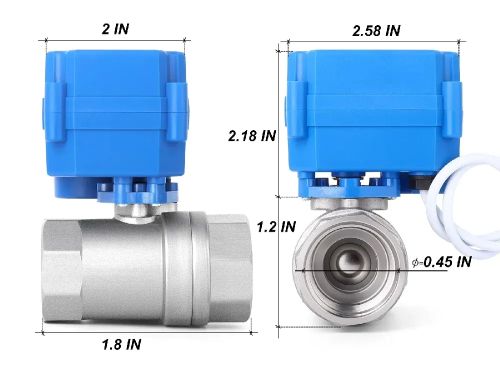


Electric Ball Valves: A Comprehensive Guide to Operation, Applications, and Maintenance
Introduction
We are a leading control valve manufacturer in China, delivering high-quality valves and control actuators customized to meet a wide range of industrial requirements.
Electric ball valves play a critical role in modern fluid control systems across industrial and commercial sectors. By combining mechanical efficiency with electrical automation, these valves offer fast, precise, and reliable control over the flow of liquids and gases. Unlike manual valves, electric ball valves can be operated remotely, making them ideal for environments where safety, speed, or convenience is a priority.
This article outlines how electric ball valves work, where they are commonly used, and how to maintain them. It also highlights the importance of power-failure reset mechanisms to ensure safe operation during outages.
What Is an Electric Ball Valve?
An electric ball valve is an automated valve that uses an electric actuator to rotate a spherical ball with a hole through its center. As the actuator turns the ball 90°, it aligns or misaligns the bore with the pipeline, allowing or stopping flow. These valves can fully open, close, or partially open depending on the control signal.
Key Features
Quick Actuation: Opens or closes in seconds, suitable for time-sensitive systems
Accurate Flow Control: Capable of partial opening for modulated flow
Durable Construction: Built to endure high pressures and harsh environments
Automation-Friendly: Compatible with PLCs, SCADA systems, and IoT platforms
How It Works
When an electric signal is received, the actuator drives the valve stem, rotating the ball to the required position. Positioners ensure the ball aligns precisely based on control input. This eliminates the need for manual operation and allows integration into fully automated systems.
Typical Applications
Electric ball valves are widely used in:
Industrial Systems: For fluid handling in chemical plants, water treatment, and oil & gas pipelines
HVAC: To control heating/cooling flows and manage energy efficiency
Food & Beverage: For hygienic, accurate batching and flow control
Power Generation: In steam lines and coolant flow regulation
Safety Systems: As emergency shut-off valves in fire protection and gas leak prevention
Troubleshooting Common Issues
Despite their reliability, problems may occur:
Slow or erratic operation: Often due to low voltage—check power supply
Sticking or friction: Caused by debris or lack of lubrication—clean and service valve
Signal interference: Can result from nearby electromagnetic equipment—add shielding or relocate
Wear and tear: Worn seals or components should be inspected and replaced as needed
Maintenance Best Practices
Regular preventive maintenance helps extend service life:
Inspect for leaks or corrosion
Ensure proper installation and secure wiring
Use upstream filters like Y-strainers to prevent clogging
Schedule lubrication and test valve responsiveness periodically
Power-Failure Reset Systems
To maintain safety during power loss, many electric ball valves include automatic closure mechanisms:
Spring Return: Uses stored mechanical energy to force the valve shut
Battery/Capacitor Backup: Maintains control to close the valve smoothly after power loss
These features are essential in critical systems—like chemical processing or gas lines—where uncontrolled flow can pose serious risks.
Conclusion
Electric ball valves offer smart, safe, and efficient fluid control across a wide range of applications. Their ability to integrate into automated systems, combined with fast actuation and low maintenance, makes them a top choice in modern infrastructure. With proper selection, maintenance, and the use of safety features like power-failure reset systems, these valves provide long-term value and reliability.Know more about Google SEO Directory
